Sensitivity of Risk-Based Maintenance Planning of Offshore Wind Turbine Farms
Abstract
:1. Introduction
2. Maintenance Strategies
Optimal Planning of Inspection and Maintenance
- probabilities of deterioration amplification;
- probabilities of monitoring/inspection results;
- probabilities of inspection results;
- probabilities of repair (costs, required time and access possibilities).
3. Uncertainty Models
3.1. Imperfect Weather Forecast
- limited number of observations;
- data errors;
- software-based and hardware-based inconsistencies between different measuring tools;
- limited time for making the forecast (trade-off between cost and quality of forecast);
- incomplete understanding about all different physical and chemical processes.
3.2. Uncertain Repair Time
3.3. Uncertain Operational Range Limitations of Boat and Helicopter
4. Failure Types and Their Corresponding Models
4.1. Mechanical Failures—Damage Model
4.2. Electrical/Software Failures—Failure Rates
5. Case Study
- only corrective maintenance actions;
- preventive and corrective maintenance actions with a fixed inspection interval of 0.5 years;
- preventive and corrective maintenance actions based on alarms from a condition monitoring system.
5.1. Considered Failure Data
5.2. Parameters for Inspection and Maintenance Modeling
5.3. Considered Costs
5.4. Considered Operational Range of Boat/Helicopter
6. Results
- weather forecast;
- assumed repair time on site;
- operational range of helicopter/boat.
6.1. Sensitivity of Weather Forecast
6.2. Sensitivity of Assumed Operational Range of Boat/Helicopter
6.3. Sensitivity of Time to Repair on Site
6.4. Sensitivity of Combination of the Different Uncertainty Sources
7. Conclusions
Acknowledgments
Author Contributions
Conflicts of Interest
References
- Yeng, Y.; Tavner, P.; Long, H. Early experiences with UK round 1 offshore wind Farms. Proc. Inst. Civ. Eng. Energy 2010, 163, 167–181. [Google Scholar]
- Musial, W.; Ram, B. Large-Scale Offshore Wind Power in the United States: Assessment of Opportunities and Barriers; NREL/TP-500-40745; National Renewable Laboratory: Denver, Co, USA, 2010.
- Maples, B.; Saur, G.; Hand, M.; van de Pietermen, R.; Obdam, T. Installation, Operation, and Maintenance Strategies to Reduce the Cost of Offshore Wind Energy; NREL/TP-5000-57403; National Renewable Laboratory: Denver, CO, USA, 2013.
- Hofmann, M. A review of decision support models for offshore wind farms with an emphasis on operation and maintenance strategies. Wind Eng. 2011, 35, 1–16. [Google Scholar] [CrossRef]
- Arunraj, N.S.; Maiti, J. Risk-based maintenance—Techniques and applications. J. Hazard. Mater. 2006, 142, 653–661. [Google Scholar] [CrossRef] [PubMed]
- Faber, M.; Stewart, M.G. Risk assessment for civil engineering facilities: Critical overview and discussion. Reliab. Eng. Syst. Saf. 2003, 80, 173–184. [Google Scholar] [CrossRef]
- Nielsen, J.J.; Sørensen, J.D. On risk-based operation and maintenance of offshore wind turbine components. Reliab. Eng. Syst. Saf. 2011, 96, 218–229. [Google Scholar] [CrossRef]
- Florian, M.; Sørensen, J.D. Wind turbine blade life-time assessment model for preventive planning of operation and maintenance. J. Mar. Sci. Eng 2015, 3, 1027–1040. [Google Scholar] [CrossRef]
- Brennan, F. Risk based maintenance for offshore wind structures. Procedia CIRP 2013, 11, 296–300. [Google Scholar] [CrossRef]
- Sørensen, J.D. Framework for risk-based planning of operation and maintenance for offshore wind turbines. Wind Energy 2009, 12, 493–506. [Google Scholar] [CrossRef]
- Nielsen, J.S.; Sørensen, J.D. Methods for risk-based planning of O&M of wind turbines. Energies 2014, 7, 6645–6664. [Google Scholar]
- Rangel-Ramirez, J.G.; Sørensen, J.D. Risk-based inspection planning optimisation of offshore wind turbines. Struct. Infrastruct. Eng. 2012, 8, 473–481. [Google Scholar] [CrossRef]
- Ambühl, S.; Sørensen, J.D. On Different Maintenance Strategies for Casted Components of Offshore Wind Turbines; DCE No. 222; Aalborg University: Aalborg, Denmark, 2017. [Google Scholar]
- Gintautas, T.; Sørensen, J.D. Evaluating a novel approach to reliability based decision support for offshore wind turbine installation. In Proceedings of the 2nd International Conference on Renewable Energies Offshore, Lisbon, Portugal, 24–26 October 2016; pp. 733–740. [Google Scholar]
- Seyr, H.; Muskulus, M. Value of information of repair times for offshore wind farm maintenance planning. J. Phys. Conf. Ser. 2016, 753, 092009. [Google Scholar] [CrossRef]
- Lange, M. On the uncertainty of wind power predictions—Analysis of the forecast accuracy and statistical distribution of error. J. Sol. Energy Eng. 2005, 127, 177–184. [Google Scholar] [CrossRef]
- Möhrlen, C. Uncertainty in Wind Energy Forecasting. Ph.D. Thesis, University College Cork, Cork, Ireland, 2004. [Google Scholar]
- Ko, W.; Hur, D.; Park, J.-K. Correction of wind power forecasting by considering wind speed forecast error. J. Int. Counc. Electr. Eng. 2015, 5, 47–50. [Google Scholar] [CrossRef]
- Babovic, V.; Sannasiraj, S.A.; Chan, E.S. Error correction of a predictive ocean wave model using local model approximation. J. Mar. Syst. 2015, 53, 1–17. [Google Scholar] [CrossRef]
- Natskår, V.; Moan, T.; Alvær, P.Ø. Uncertainty in forecasted environmental conditions for reliability analyses of marine operations. Ocean Eng. 2015, 108, 636–647. [Google Scholar] [CrossRef]
- Wilcken, S. Alpha Factors for the Calculation of Forecasted Operational Limits for Marine Operations in the Barents Sea. Master’s Thesis, University of Stavanger, Stavanger, Norway, 2015. [Google Scholar]
- Gintautas, T.; Sørensen, J.D.; Vatne, S.R. Towards a risk-based decision support for offshore wind turbine installation and operation & maintenance. Energy Procedia 2016, 94, 207–217. [Google Scholar]
- Ambühl, S.; Kofoed, J.P.; Sørensen, J.D. Operation and maintenance strategies for wave energy converters. Inst. Mech. Eng. Proc. Part O J. Risk Reliab. 2015, 229, 417–441. [Google Scholar] [CrossRef]
- Paris, P.C.; Erdogan, F. A critical analysis of crack propagation laws. J. Basic Eng. 1963, 85, 528–533. [Google Scholar] [CrossRef]
- Straub, D. Generic Approaches to Risk-Based Inspection Planning for Steel Structures. Ph.D. Thesis, Swiss Federal Institute of Technology—ETH Zurich, Zurich, Switzerland, 2004. [Google Scholar]
- Tavner, P.J.; Xiang, J.; Spinato, F. Reliability analysis of wind turbines. Wind Energy 2007, 10, 1–18. [Google Scholar] [CrossRef]
- Wilkinson, M.; Harman, K.; Hendriks, B.; Spinato, F.; van Delft, T. Methodology and results of the ReliaWind reliability field study. In Proceedings of the Scientific Track Proceedings: European Wind Energy Conference, Warsaw, Poland, 20–23 April 2010. [Google Scholar]
- Van Brussel, J.W.; Zaaijer, M.B. Estimation of Turbine Reliability Figures within the DOWEC Project; Dutch Offshore Wind Energy Converter (DOWEC), ECN: Petten, The Netherlands, 2003. [Google Scholar]
- Ribrant, J.; Bertling, L.M. Survey of failures in wind power systems with focus on Swedish wind power plants during 1997–2005. IEEE Trans. Energy Convers. 2007, 22, 167–173. [Google Scholar] [CrossRef]
- IEA Wind Task 33. Reliability Data Standardization of Data Collection for Wind Turbine Reliability and Operation & Maintenance Analyses; International Energy Agency (IEA): Geneva, Switzerland, 2012. [Google Scholar]
- Carroll, J.; McDonald, A.; McMillian, D. Failure rate, repair time and unscheduled O&M cost analysis of offshore wind turbines. Wind Energy 2016, 19, 1107–1119. [Google Scholar]
- Faulstich, D.; Hahn, B.; Tavner, B.J. Wind turbine downtime and its importance for offshore deployment. Wind Energy 2011, 14, 327–337. [Google Scholar] [CrossRef]
- Offshore and Onshore Reliability Data (OREDA) Project. Offshore Reliability Data Handbook; SINTEF and OREDA Participants: Trondheim, Norway, 2009. [Google Scholar]
- IEE Std 500-1984. Reliability Data for Pumps and Drivers, Valve Actuators and Valves; Institute of Electrical and Electronics Engineers (IEEE): New York, NY, USA, 1984. [Google Scholar]
- MIL-HDBK-271F. Military Standardization Handbook—Reliability Prediction of Electronic Equipment; Department of Defense: Washington, DC, USA, 1991.
- Green, R.; Vasilakos, N. The economics of offshore wind. Energy Policy 2010, 39, 496–502. [Google Scholar] [CrossRef]
- Dalgic, Y.; Lazakis, I.; Turan, O. Investigation of optimum crew transfer vessel fleet for offshore wind farm maintenance operations. Wind Eng. 2015, 39, 31–52. [Google Scholar] [CrossRef]
- Poore, R.; Walford, C. Development of an Operations and Maintenance Cost Model to Identify Cost of Energy Savings for Low Wind Speed Turbines; NREL/SR-500-40581; National Renewable Laboratory: Denver, CO, USA, 2008.
- Logistics Efficiencies and Naval Architecture for Wind Installations with Novel Developments (LEANWIND) Project. Work Package 3—Deliverable 3.1—Novel Vessels and Equipment; University College Cork: Cork, Ireland, 2014. [Google Scholar]
- Bierbooms, W.A.A.M.; van Bussel, G.J.W. The impact of different means of transport on the operation and maintenance strategy for offshore wind farms. In Section Wind Energy, Faculty Civil Engineering and Geosciences; Delft University of Technology: Delft, The Netherlands, 2002. [Google Scholar]
- Martin, R.; Lazakis, I.; Barbouchi, S.; Johanning, L. Sensitivity analysis for offshore wind farm operation and maintenance cost and availability. Renew. Energy 2016, 85, 1226–1236. [Google Scholar] [CrossRef]

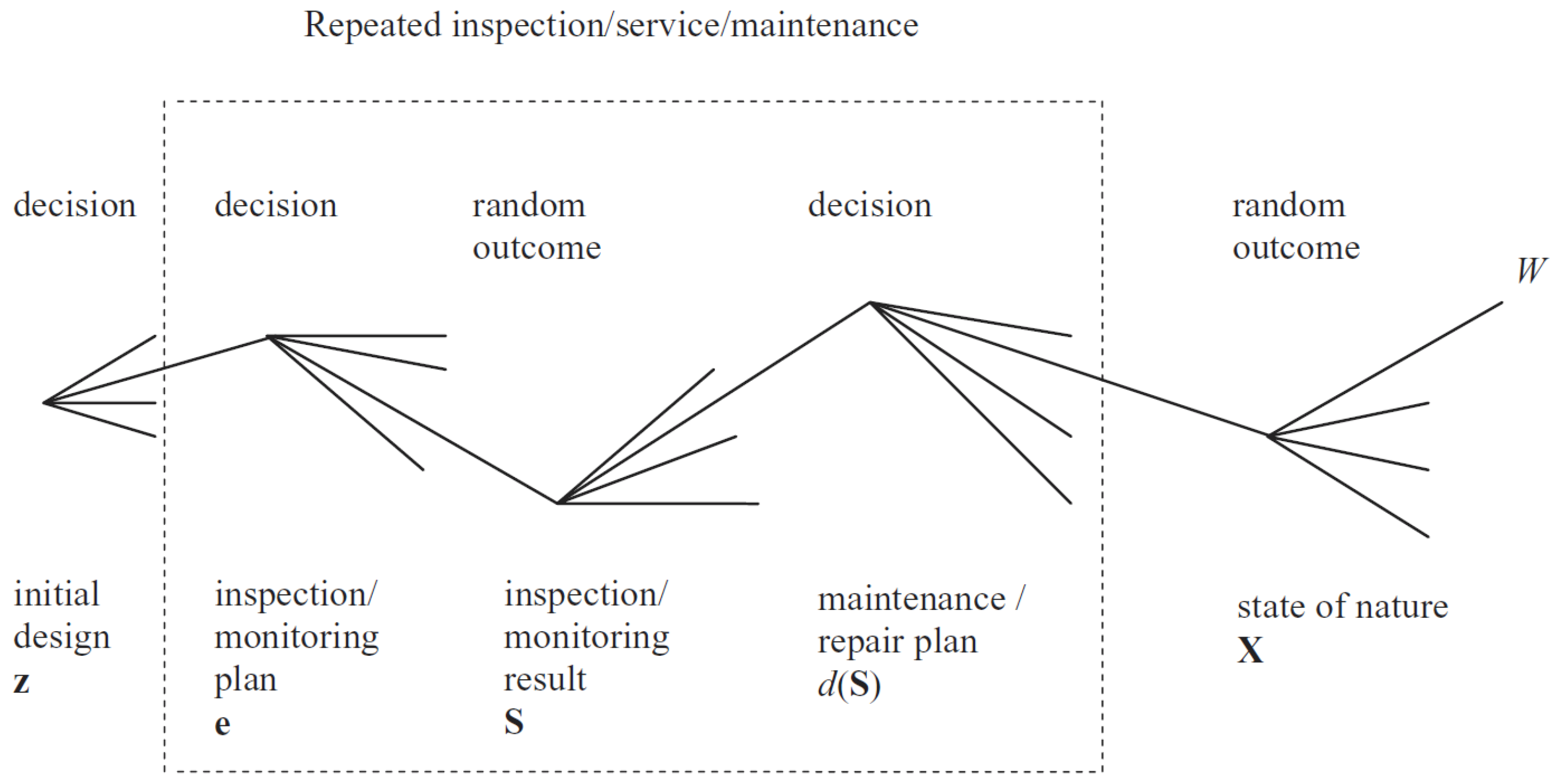
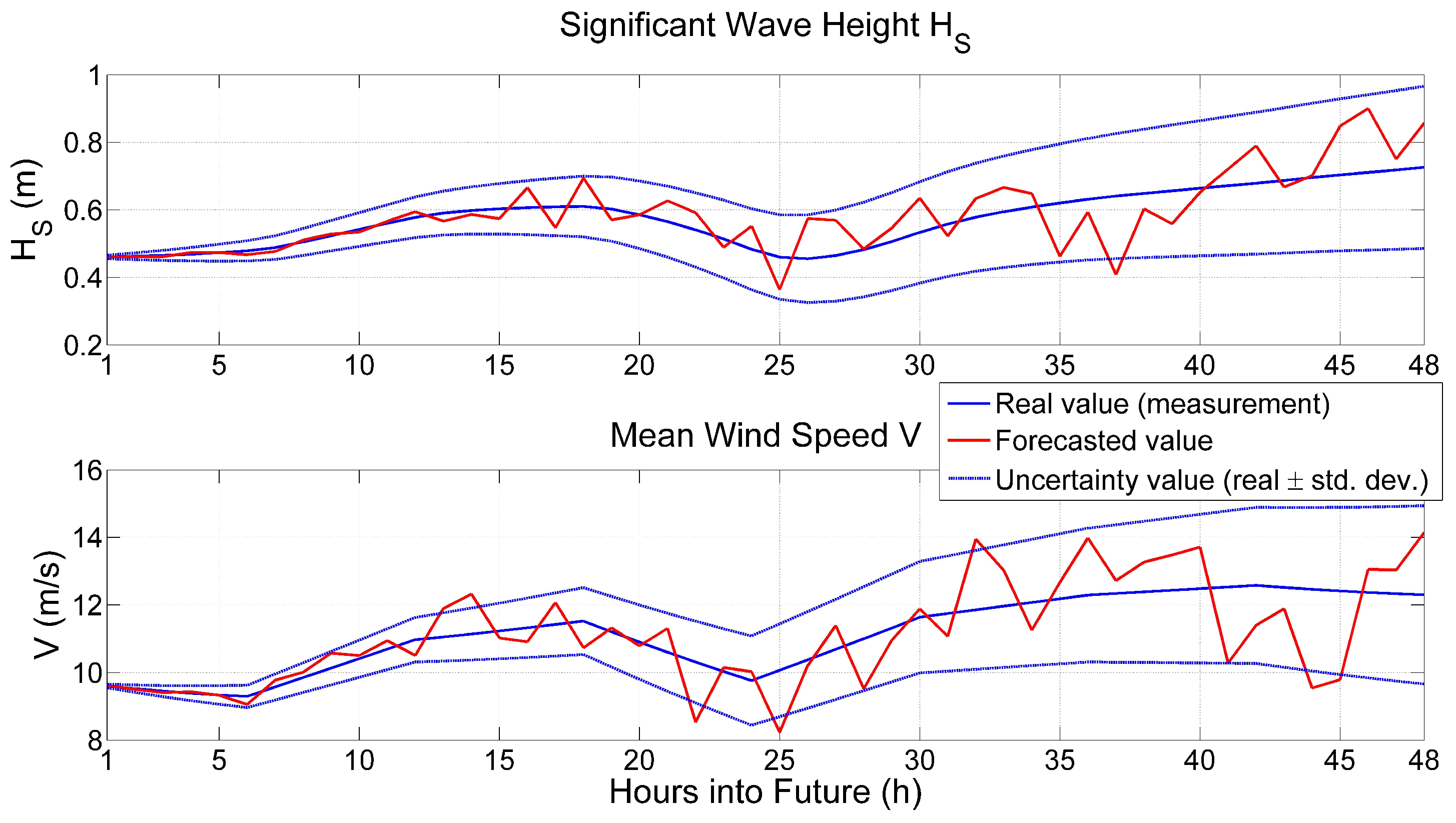
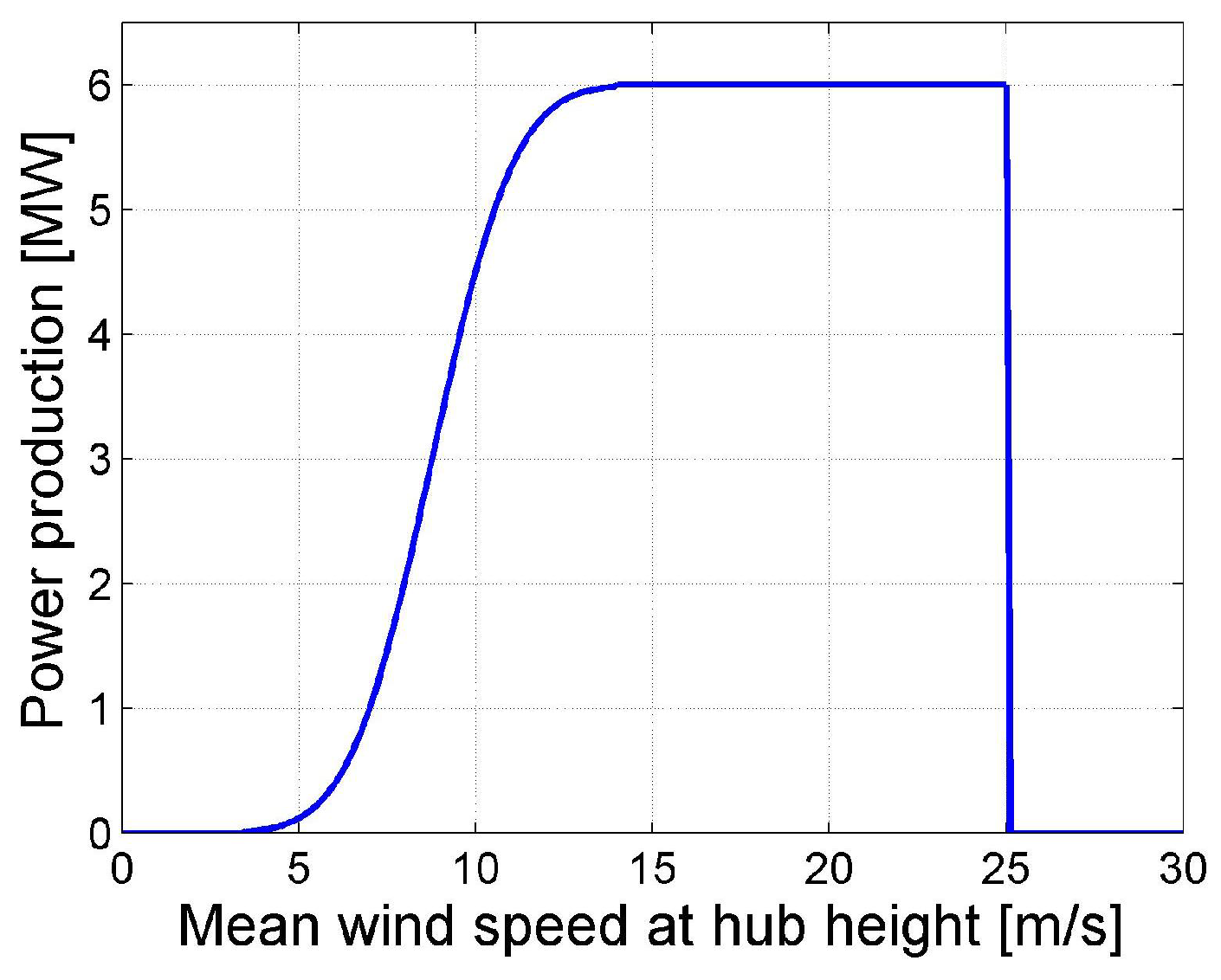
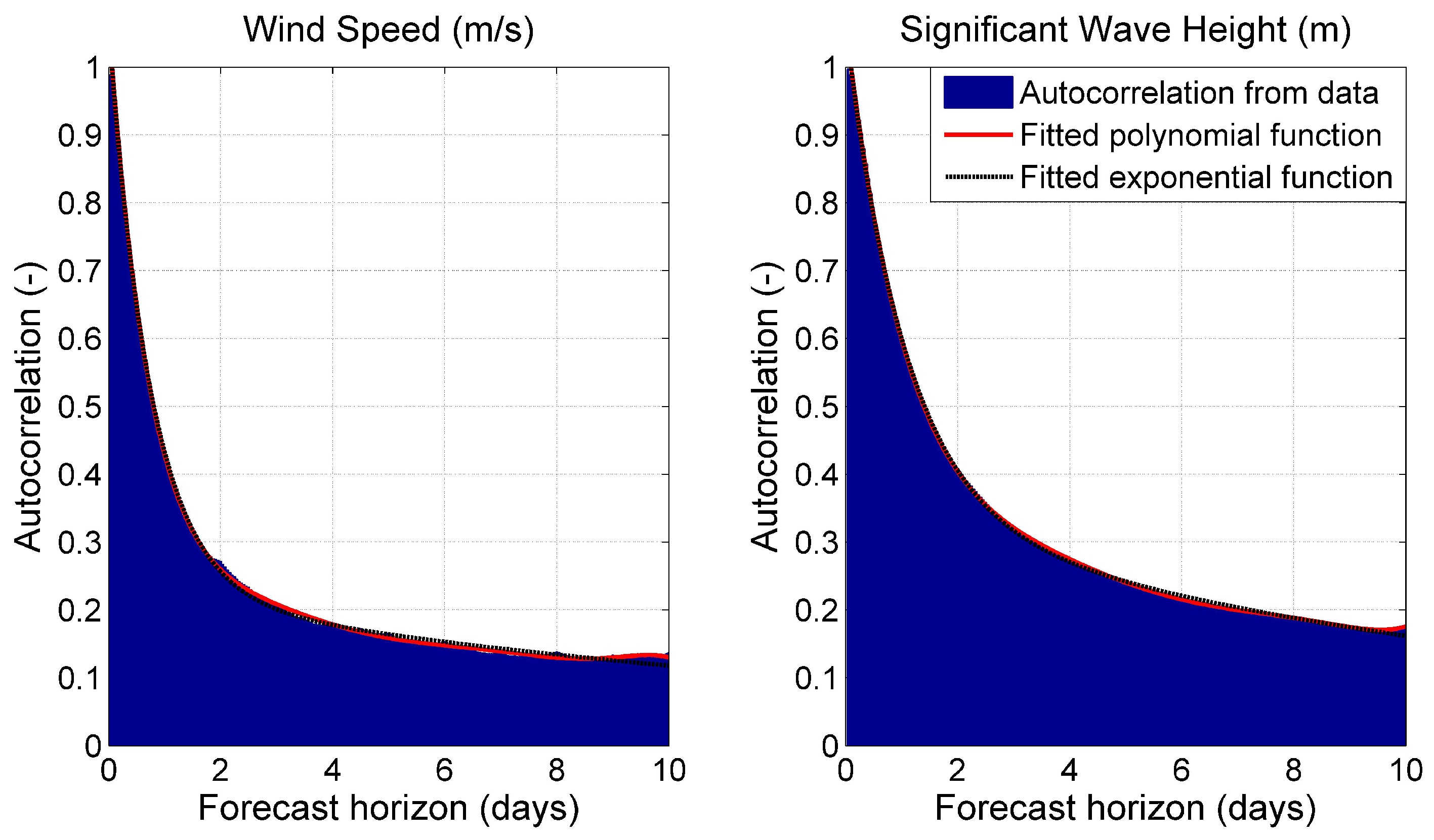

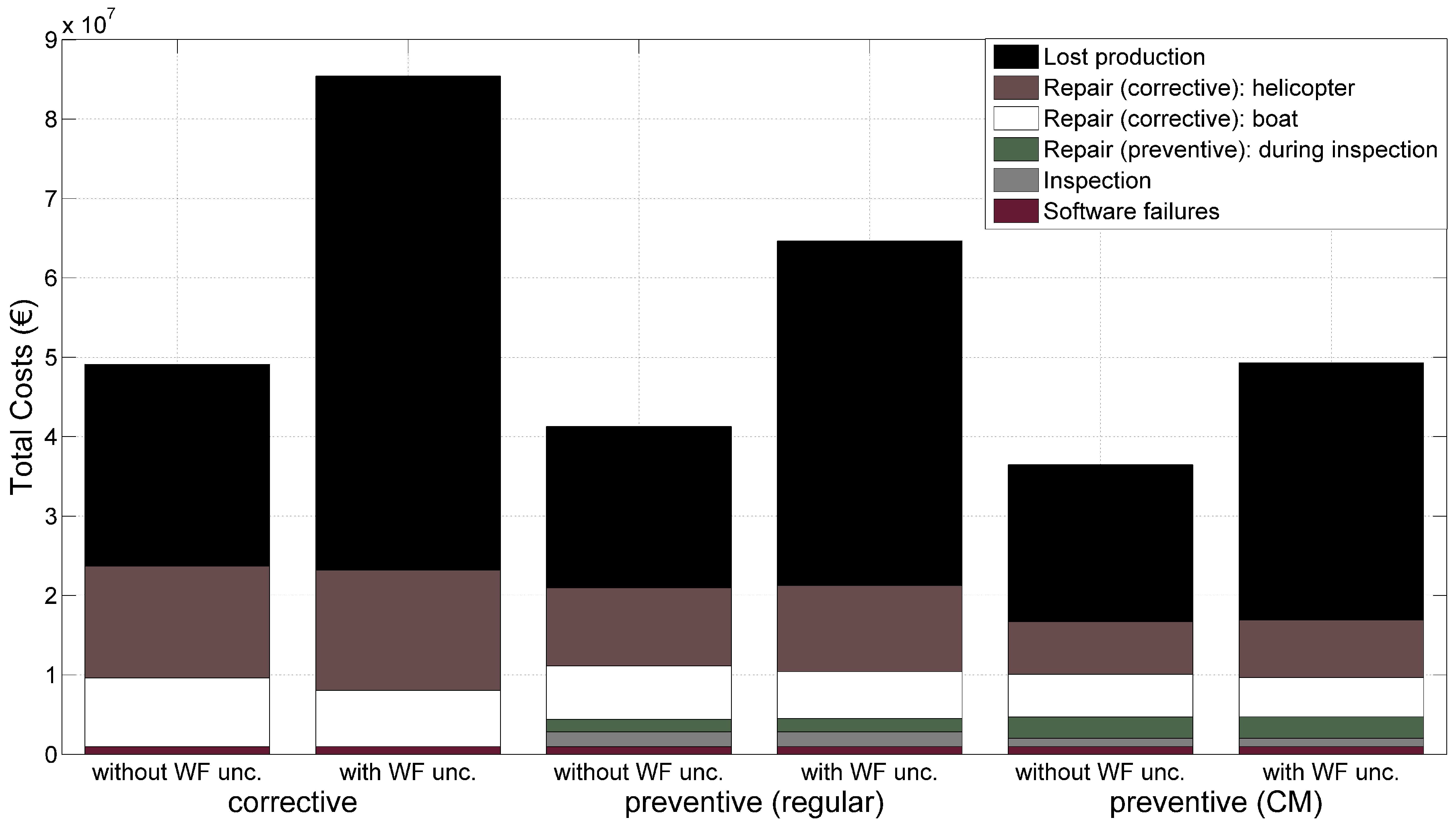
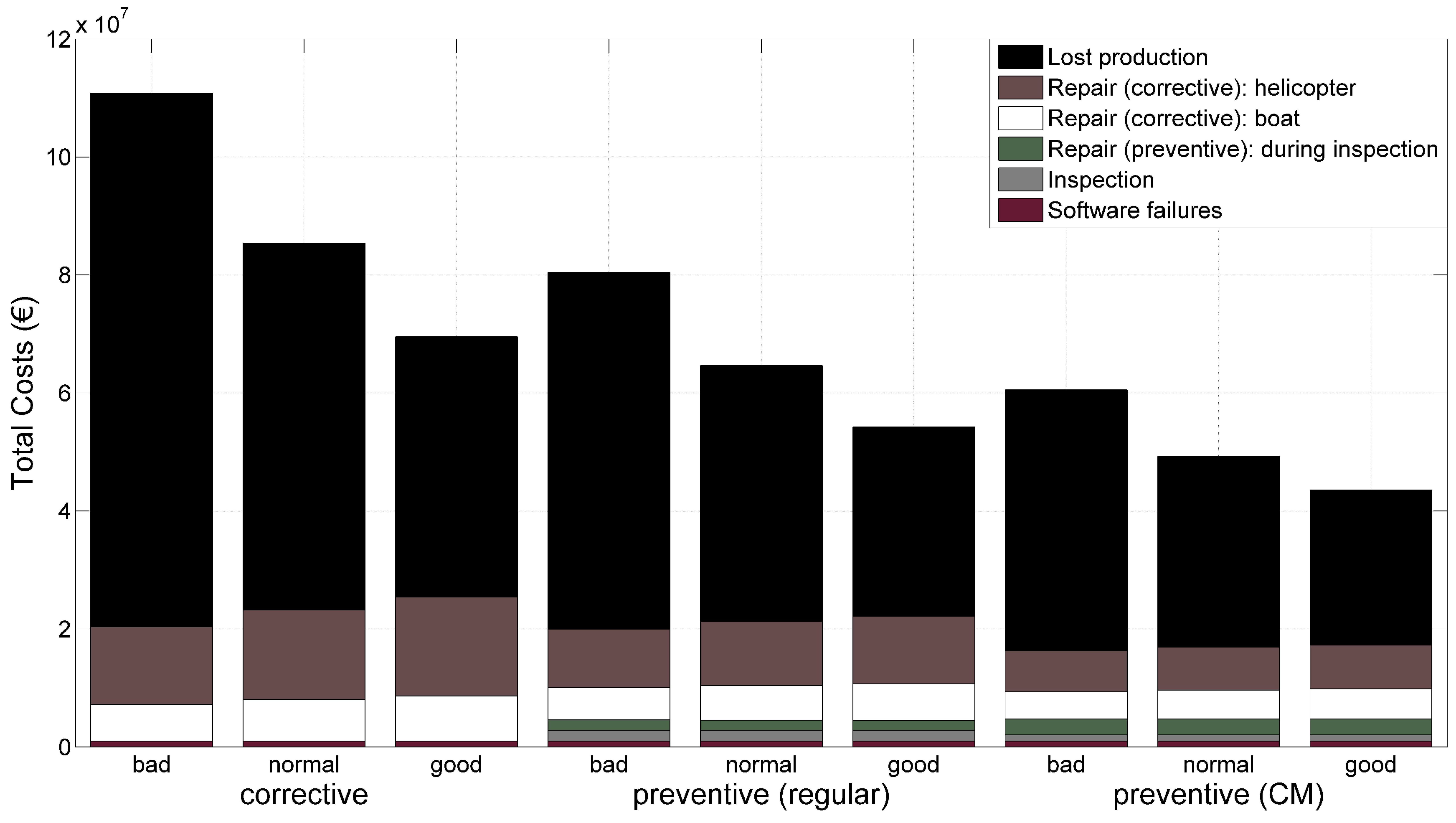
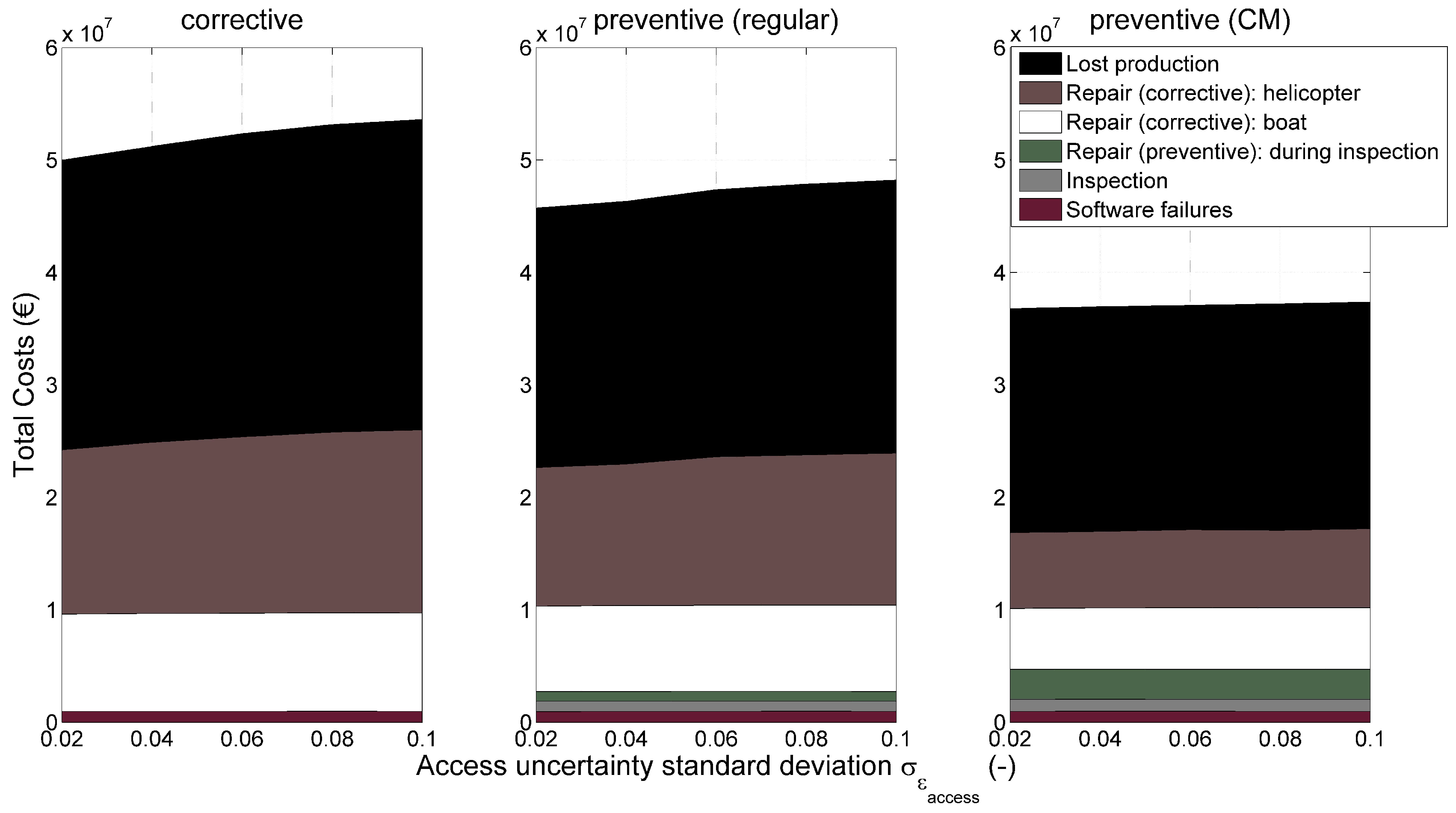
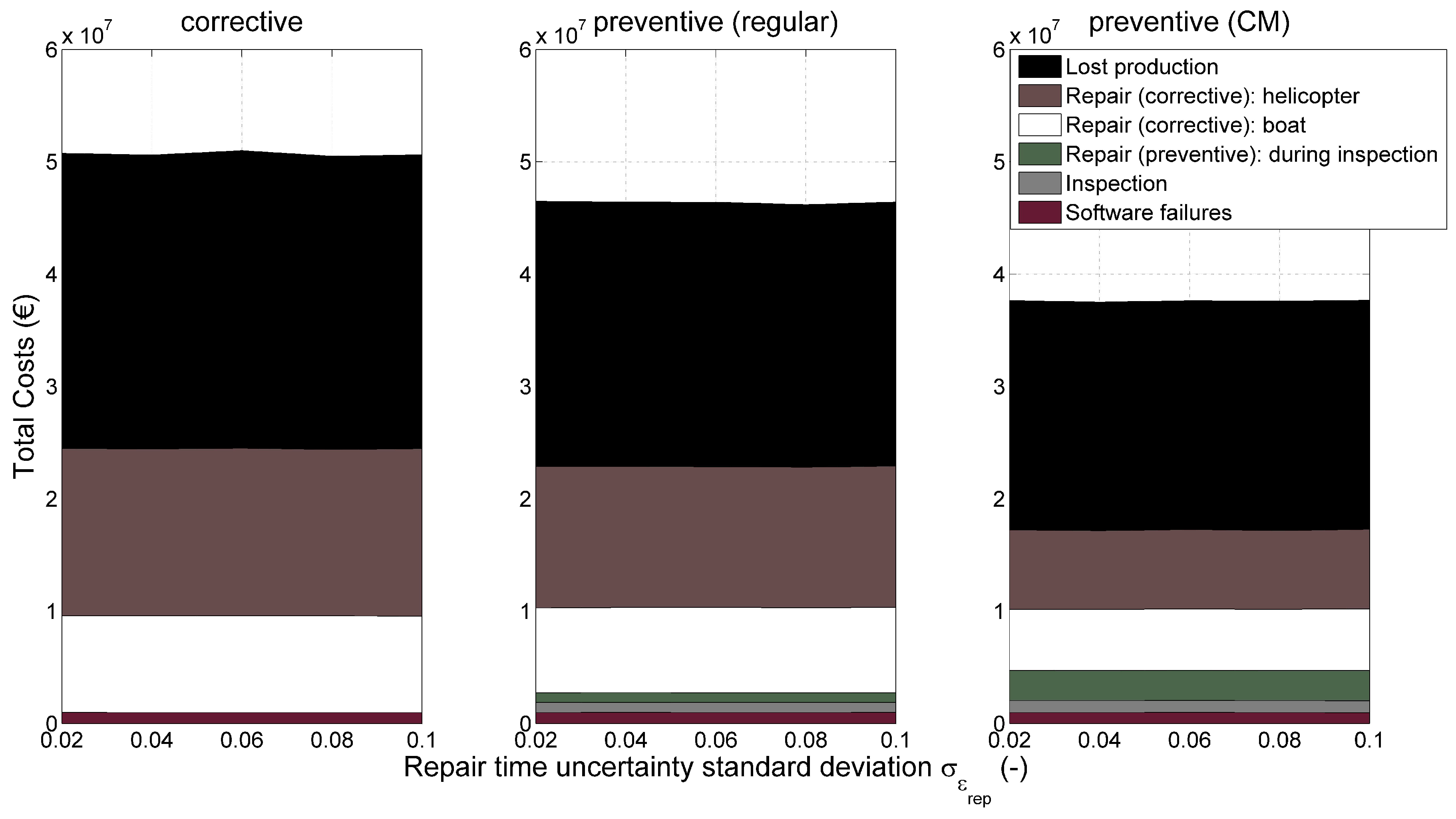
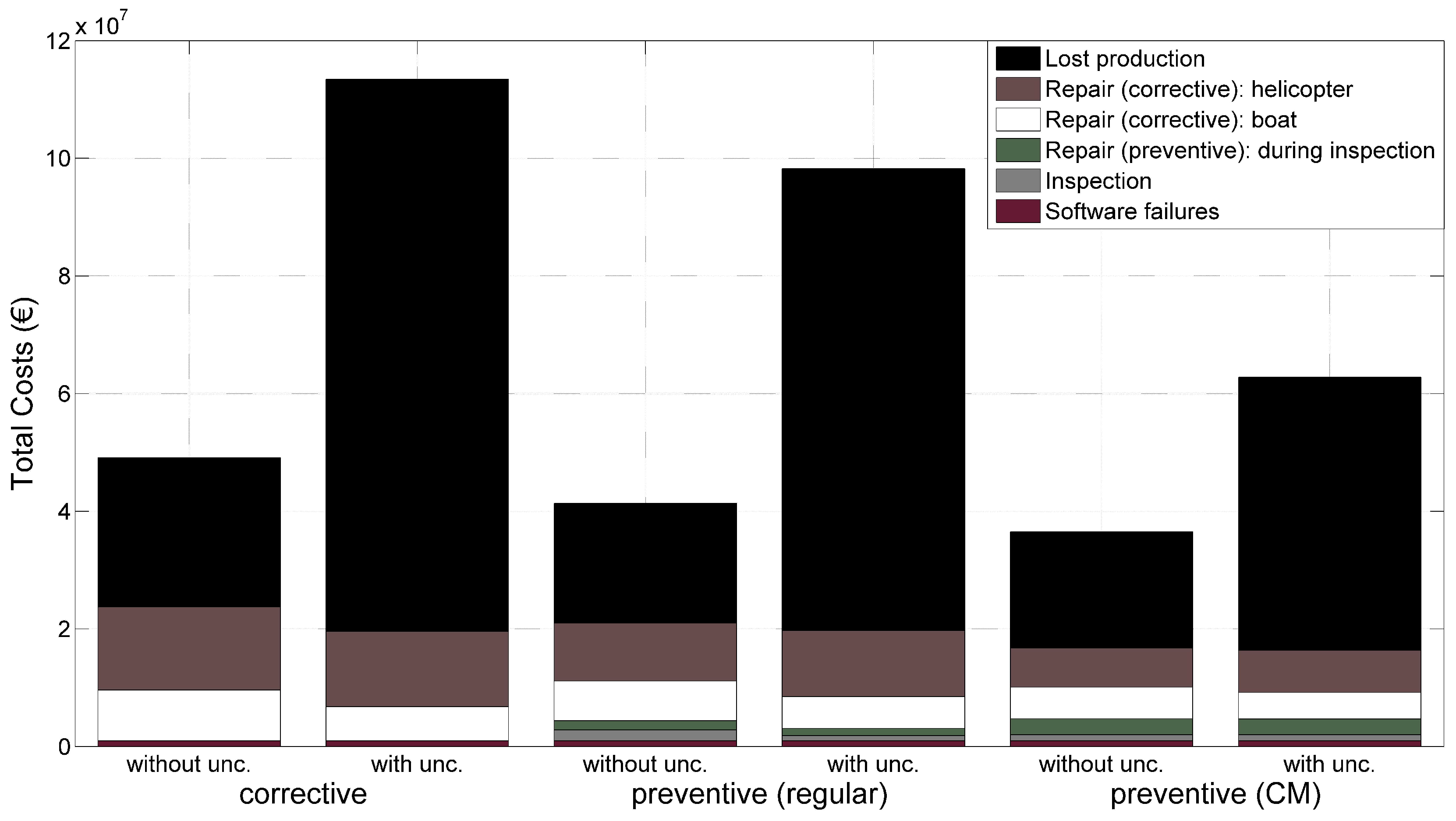
| Description | Forecast Term | |
|---|---|---|
| Mean Value | Std. Deviation | |
| Wind speed (m/s) | 0 | 0.055·t |
| Sig. wave height (m) | 0 | 0.005·t |
| Component | Dam. Exp. | Geom. Factor | Dam. Coefficient C | Proportionality Factor | ||
|---|---|---|---|---|---|---|
| m | Mean | COV | Mean | COV | ||
| Rotor system | 2 | 1 | 1.16 × 10 | 0.2 | 9.2 | 0.1 |
| Blade adjustment | 2.38 × 10 | 10 | ||||
| Gearbox | 1.65 × 10 | 8.6 | ||||
| Generator | 2.16 × 10 | 6 | ||||
| HSS | 1.07 × 10 | 3 | ||||
| LSS | 1.05 × 10 | 2.7 | ||||
| Yaw system | 1.57 × 10 | 8.2 | ||||
| Description | Mean Annual Failure Rates | Failure Type |
|---|---|---|
| Generator | 1.092 | electrical/software |
| Generator lead | 0.847 | electrical |
| Control and protection system turbine | 1.569 | electrical/software |
| Transformer station | 0.147 | electrical |
| Symbol | Meaning | Mean | COV | Distribution |
|---|---|---|---|---|
| Maximum probability of detection | 1 | - | Deterministic | |
| Expected smallest detectable damage | 0.4 | 0.1 | Normal | |
| Minimal damage for reparation/replacement | 0.3 | - | Deterministic | |
| Damage threshold for alarm of condition monitoring system | 0.8 | - | Deterministic |
| Description | Component Type | Expected Repair Costs (€) |
|---|---|---|
| Rotor system | mechanical | 4250 |
| Blade adjustment | mechanical | 4770 |
| Gearbox | mechanical | 5000 |
| Generator | mechanical/electrical | 7000 |
| Generator lead/cables | electrical | 9860 |
| HSS part | mechanical | 6530 |
| LSS part | mechanical | 6530 |
| Yaw system | mechanical | 8380 |
| Control and protection system turbine | electrical | 4400 |
| Transformer station | electrical | 14,520 |
| Description | Days Needed on Site for Repair | |
|---|---|---|
| Mean | COV | |
| Rotor system | 4 | 0.5 |
| Blade adjustment | 2 | |
| Gearbox | 3 | |
| Generator | 3 | |
| Generator lead | 2 | |
| HSS part | 3 | |
| LSS part | 3 | |
| Yaw system | 3 | |
| Control and protection system turbine | 2 | |
| Transformer station | 3 | |
| Description | Costs (€) | Rate (%) |
|---|---|---|
| Labor costs per day | 3600€ | - |
| Inspection (material) costs per component | 1000€ | - |
| Transportation cost by boat | 5000€ | - |
| Transportation cost by helicopter | 10,000€ | - |
| Interest rate r | - | 5% |
| Maintenance Strategy | Corrective | Preventive (Regular) | Preventive (CM) | |||
|---|---|---|---|---|---|---|
| Weather Forecast | Perfect | Imperfect | Perfect | Imperfect | Perfect | Imperfect |
| Availability (time-based) | 0.916 | 0.761 | 0.930 | 0.834 | 0.920 | 0.870 |
| Availability (power-based) | 0.903 | 0.744 | 0.922 | 0.823 | 0.925 | 0.871 |
| O&M expenses/KWh (€/KWh) | 0.016 | 0.034 | 0.014 | 0.023 | 0.012 | 0.017 |
| O&M expenses/KWh (%) | 20.5 | 42.3 | 16.7 | 29.3 | 14.9 | 21.3 |
| COV total maintenance expenses (-) | 0.063 | 0.211 | 0.065 | 0.243 | 0.068 | 0.246 |
| Description | Maintenance Strategy | ||
|---|---|---|---|
| Corrective | Preventive (Reg.) | Preventive (CM) | |
| Total maintenance expenses ratio | 2.309 | 2.378 | 1.721 |
| Availability ratio (time-based) | 0.690 | 0.746 | 0.884 |
| Availability ratio (power-based) | 0.681 | 0.734 | 0.878 |
| O&M expenses/KWh ratio | 3.231 | 3.132 | 1.935 |
| COV total maintenance expenses ratio | 3.006 | 3.346 | 3.712 |
© 2017 by the authors. Licensee MDPI, Basel, Switzerland. This article is an open access article distributed under the terms and conditions of the Creative Commons Attribution (CC BY) license (http://creativecommons.org/licenses/by/4.0/).
Share and Cite
Ambühl, S.; Dalsgaard Sørensen, J. Sensitivity of Risk-Based Maintenance Planning of Offshore Wind Turbine Farms. Energies 2017, 10, 505. https://doi.org/10.3390/en10040505
Ambühl S, Dalsgaard Sørensen J. Sensitivity of Risk-Based Maintenance Planning of Offshore Wind Turbine Farms. Energies. 2017; 10(4):505. https://doi.org/10.3390/en10040505
Chicago/Turabian StyleAmbühl, Simon, and John Dalsgaard Sørensen. 2017. "Sensitivity of Risk-Based Maintenance Planning of Offshore Wind Turbine Farms" Energies 10, no. 4: 505. https://doi.org/10.3390/en10040505







